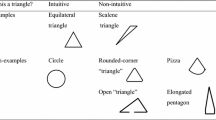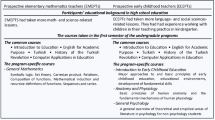Abstract
Action-Process-Object-Schema (APOS) theory and the triad of schema development are used as the framework in this study to investigate students’ understanding of the concept of circle. In this report, results are presented from the data analysis of responses to questions in semi-structured interviews of 15 students enrolled in a college geometry course at a university. This report utilizes a framework describing the interaction of the Taxicab geometry and Euclidean geometry schemata to determine what components of these, and what relationships between them, were evoked when these participating students elaborated on their understanding of the circle concept. By adapting and transferring their knowledge of concepts back and forth between these two geometries, the participants demonstrated a variety of levels of schema interaction when responding to interview questions pertaining to circles. As a result, a model of schema interaction and pedagogical suggestions to help students better develop their circle schema are provided.












Similar content being viewed by others
Data availability
The data that support the findings of this study are available from the corresponding author upon request.
References
Arnon, I., Cottrill, J., Dubinsky, E., Oktaç, A., Fuentes, S. R., Trigueros, M., & Weller, K. (2014). APOS theory: A framework for research and curriculum development in mathematics education. Springer Science & Business Media.
Asiala, M., Cottrill, J., Dubinsky, E., & Schwingendorf, K. E. (1997). The development of students' graphical understanding of the derivative. The Journal of Mathematical Behavior, 16(4), 399–431.
Baker, B., Cooley, L., & Trigueros, M. (2000). A calculus graphing schema. Journal for Research in Mathematics Education, 31(5), 557–578.
Chesler, J. (2012). Pre-service secondary mathematics teachers making sense of definitions of functions. Mathematics Teacher Education and Development, 14(1), 27–40.
Clark, J. M., Cordero, F., Cottrill, J., Czarnocha, B., DeVries, D. J., John, D. S., & Vidakovic, D. (1997). Constructing a schema: The case of the chain rule. The Journal of Mathematical Behavior, 16(4), 345–364.
Cobb, P., & Steffe, L. P. (1983). The constructivist researcher as teacher and model builder. Journal for Research in Mathematics Education, 14(2), 83–94.
Cottrill, J. F. (1999). Students' understanding of the concept of chain rule in first year calculus and the relation to their understanding of composition of functions. (Doctoral dissertation. Purdue University).
Dreiling, K. M. (2012). Delving deeper: Triangle construction in taxicab geometry. The Mathematics Teacher, 105(6), 474–478.
Dubinsky, E. (2002). Reflective abstraction in advanced mathematical thinking. In D. Tall (Ed.), Advanced mathematical thinking (vol. 11, pp. 95–126). Springer.
Edwards, B., & Ward, M. B. (2008). Undergraduate mathematics courses. Making the Connection: Research and Teaching in Undergraduate Mathematics Education, 73(2), 223–232.
Edwards, B. S., & Ward, M. B. (2004). Surprises from mathematics education research: Student (mis) use of mathematical definitions. The American Mathematical Monthly, 111(5), 411–424.
Fenton, W., & Reynolds, B. E. (2011). College geometry: Using the Geometer's Sketchpad. Wiley.
Fischbein, E. (1993). The theory of figural concepts. Educational Studies in Mathematics, 24(2), 139–162.
Hollebrands, K. F., Conner, A., & Smith, R. C. (2010). The nature of arguments provided by college geometry students with access to technology while solving problems. Journal for Research in Mathematics Education, 41(4), 324–350.
Jenkins, T. L. (1968). Euclid, you must be kidding. Mathematics Magazine, 41(1), 34–37.
Kemp, A. (2018). Generalizing and Transferring Mathematical Definitions from Euclidean to Taxicab Geometry. (Doctoral Dissertation. Georgia State University).
Kemp, A., & Vidakovic, D. (2018). A student’s use of definitions in the derivation of the Taxicab circle equation. In: A. Weinberg, C. Rasmussen, J. Rabin, M. Wawro, & S. Brown (Eds.), Proceedings of the 21st annual conference on research in undergraduate mathematics education (pp. 1394–1399). The Special Interest Group of the Mathematical Association of America (SIGMAA) for Research in Undergraduate Mathematics Education. http://sigmaa.maa.org/rume/RUME21.pdf
Kemp, A., & Vidakovic, D. (2019). The transfer and application of definitions from Euclidean to taxicab geometry: Circle. In: A. Weinberg, D. Moore-Russo, H. Soto, & M. Wawro (Eds.), Proceedings of the 22nd annual conference on research in undergraduate mathematics education (pp. 324–331). The Special Interest Group of the Mathematical Association of America (SIGMAA) for Research in Undergraduate Mathematics Education. http://sigmaa.maa.org/rume/RUME22_Proceedings.pdf
Kemp, A., & Vidakovic, D. (2021a). Ways secondary mathematics teachers apply definitions in Taxicab geometry for a real-life situation: Midset. The Journal of Mathematical Behavior, 62, 100848.
Kemp, A., & Vidakovic, D. (2021b). The circle schema: An example of schema interaction in college geometry. In: S. S. Karunakaran & A. Higgins (Eds.), 2021 research in undergraduate mathematics education reports (pp. 147–155). The Special Interest Group of the Mathematical Association of America (SIGMAA) for Research in Undergraduate Mathematics Education. http://sigmaa.maa.org/rume/2021_RUME_Reports.pdf
Krause, E. F. (1973). Taxicab geometry. The. Mathematics Teacher, 66(8), 695–706.
Leikin, R., & Winicki-Landman, G. (2001). Defining as a vehicle for professional development of secondary school mathematics teachers. Mathematics Teacher Education and Development, 3(2001), 62–73.
McDonald, M. A., Mathews, D., & Strobel, K. (2000). Understanding sequences: A tale of two objects. Research in Collegiate Mathematics Education IV, 8, 77–102.
Moore-Russo, D. (2008). Use of definition construction to help teachers develop the concept of slope. In: O. Figueras, J. L. Cortina, S. Alatorre, T. Rojano, & A. Sepúlveda (Eds.), Proceedings of the joint meeting of international group for the psychology of mathematics education and the North American group for the psychology of mathematics education (Vol. 3, pp. 407–414). Cinvestav-UMSNH. https://citeseerx.ist.psu.edu/viewdoc/download?doi=10.1.1.688.897&rep=rep1&type=pdf#page=436
Piaget, J., Garcia, R., & Garcia III, R. (1989). Psychogenesis and the history of science. Columbia University Press.
Selden, A. (2012). Transitions and proof and proving at tertiary level. In G. Hanna & M. de Villiers (Eds.), Proof and proving in mathematics education (vol. 15, pp. 391–420). Springer.
Siegal, M., Borasi, R., & Fonzi, J. (1998). Supporting students' mathematical inquiries through reading. Journal for Research in Mathematics Education, 29(4), 378–413.
Stalvey, H. E., & Vidakovic, D. (2015). Students’ reasoning about relationships between variables in a real-world problem. The Journal of Mathematical Behavior, 40, 192–210.
Steffe, L. P., & Thompson, P. W. (2000). Teaching experiment methodology: Underlying principles and essential elements. Handbook of research design in mathematics and science education, 267–306.
Trigueros, M. (2000). Students’ conceptions of solution curves and equilibrium in systems of differential equations. In: M. Fernandez (Ed.), Proceedings of the 22nd annual meeting of the North American Chapter of the International Group for the Psychology of Mathematics Education (Vol. 1–2, pp. 93–97). ERIC/CSMEE. https://eric.ed.gov/?q=ED446945
Trigueros, M. (2001). Analysis of students’ strategies when solving systems of differential equations in a graphical context. In: R. Speiser, C. Maher & C. Walter (Eds.), Proceedings of the 23rd annual meeting of the North American Chapter of the International Group for the Psychology of Mathematics Education (pp. 529–537). ERIC/CSMEE. https://eric.ed.gov/?q=ED476613
Trigueros, M. (2004). Understanding the meaning and representation of straight line solutions of systems of differential equations. In: D. E. McDougall & J. A. Ross (Eds.), Proceedings of the 26th annual meeting of the North American Chapter of the International Group for the Psychology of Mathematics Education (Vol. 1, pp. 127–134). OISE/UT. http://www.pmena.org/pmenaproceedings/PMENA%2026%202004%20Proceedings%20Vol%201.pdf
Vidakovic, D. (1993). Cooperative Learning: Differences Between Group and Individual Processes of Construction of the Concept of Inverse Function. (Doctoral Dissertation. Purdue University).
Wilson, P. S. (1990). Inconsistent ideas related to definitions and examples. Focus on Learning Problems in Mathematics, 12, 31–47.
Zazkis, R., & Leikin, R. (2008). Exemplifying definitions: A case of a square. Educational Studies in Mathematics, 69(2), 131–148.
Author information
Authors and Affiliations
Contributions
All coauthors acknowledge their participation in conducting the research leading to the manuscript, and all agree to its submission to be considered for publication by Educational Studies in Mathematics, and all have agreed on the final version.
The work described has not been published previously (except in the form of an abstract or as part of a published lecture or academic thesis) and that it is not under consideration for publication elsewhere.
Corresponding author
Ethics declarations
Ethics approval
Approval was obtained from the ethics committee of Georgia State University. The procedures used in this study adhere to the tenets of the Declaration of Helsinki.
Informed consent
Freely-given, informed consent to participate in the study was obtained from participants in this study.
Conflict of interest
The authors declare no competing interests.
Additional information
Publisher’s note
Springer Nature remains neutral with regard to jurisdictional claims in published maps and institutional affiliations.
Appendix Genetic decomposition of schema interaction
Appendix Genetic decomposition of schema interaction

Rights and permissions
Springer Nature or its licensor holds exclusive rights to this article under a publishing agreement with the author(s) or other rightsholder(s); author self-archiving of the accepted manuscript version of this article is solely governed by the terms of such publishing agreement and applicable law.
About this article
Cite this article
Kemp, A., Vidakovic, D. Students’ understanding and development of the definition of circle in Taxicab and Euclidean geometries: an APOS perspective with schema interaction. Educ Stud Math 112, 567–588 (2023). https://doi.org/10.1007/s10649-022-10180-2
Accepted:
Published:
Issue Date:
DOI: https://doi.org/10.1007/s10649-022-10180-2




